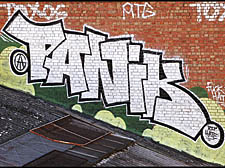|
|
 |
| |

One of Panik’s work from the streets, and pieces set for the exhibition at the Pure Evil Gallery |
Panik on streets of London
Graffiti artist ‘Panik’ is taking his work from the street to the studio after a wake-up call from the police. He tells Dan Carrier how he has adjusted to life indoors and why Banksy has damaged democratic art
THE police came knocking first thing in the morning and, considering much of his work is done in the early hours, were fortunate to find their quarry in bed.
The man they had come to arrest is known as “Panik”, a renowned graffiti artist whose work can be found not only in Camden, but across London, Bristol and even in European graffiti capitals such as Barcelona and Prague.
The dawn raid, arrest and subsequent court case means he is no longer out scaling rooftops, leaving his “Panik” calling card behind. Instead, he has had to turn his attention to painting in a studio – and the result is his first gallery show in a career during which his work has been seen by hundreds of thousands of people, emblazoned across rooftops and alongside railway lines.
The show, which starts this week, is made up of work he has produced solely indoors and is a far cry from the late-night escapades, armed with cans of spray-paint and a healthy sense of adventure, that Panik has spent years cutting his teeth on.
“The police came from Camden and Bristol,” he tells the New Journal, speaking under conditions of anonymity.
“I was on bail for a year and then got a fine, community service and a suspended sentence. It was a good time to change my outlook. I like to think of this a breather. I am focusing on putting together art rather than just bombing [a graffiti artist’s term for their work].”
Now in his mid-20s, Panik came to prominence with a group of other street artists who put their names to a graffiti crew called Ahead of the Game. You could find their tags everywhere – a top-deck bus ride along Kentish Town Road will give you a grandstand view of the nature of Panik’s earlier work.
He became an artist not only of considerable skill, but of considerable daring. His brickwork canvases required a simian climbing ability. Even with an enforced change of direction due to the arrest, you can still find Panik’s work on the rooftops in Camden Town and Kentish Town, and then right across London.
Ahead of the Game – signed off by a catchy “ATG” insignia – is respected among graffiti practitioners. To the police, it was a red rag. Panik and his friends were behind thousands of pounds’ worth of criminal damage and he was not considered an artist but a vandal.
Panik started writing graffiti when he was 12. At his Camden secondary school he would scrawl his tag on walls.
He soon became hooked, and has suffered injuries in his pursuit of his art. He once fell from a ladder on a roof in Camden Town and was knocked unconscious, badly injuring his leg. The thrill of finding hard-to-reach places – which also makes it less likely your work will be cleaned off – was one of the buzzes of his chosen work. But it was not a young man’s sense of breaking the rules that attracted him to graffiti, it was the fact that by putting his art on the streets, a huge number of people would see it.
“It’s a democratic and non-elitist,” says Panik. “Of course, I loved the whole experience of painting at night and getting your stuff across the city, but it is also the fact that your work is seen by so many people. But, as I found out, you can’t always be doing it.”
This has meant that from rooftops – where he would have to borrow ladders, scale drainpipes and then hope not to be mistaken for a burglar – he has learned to paint in the studio.
Panik says they are very different experiences.
“I loved working outside. Sometimes I’d come home at dawn after being out all night and giggle myself to sleep,” he says. “Then I’d go back out there later and see what I had done in the light of the day.
“But I have found it nice to be in the studio. It’s helped me grow in a different direction, and is making me more flexible.”
He says that despite the attentions of the police, street art is continuing to grow.
“Graffiti has become more overground, acceptable, because of the likes of Banksy,” says Panik.
“In the past you would see one name over and over again and you are just amazed by it.
“The Banksy style stuff is totally different. You get people who want to be like Banksy and they line themselves up as street artists for commercial purposes. That is not real. There is an attitude that you want to be celebrated in galleries and make sales and I can’t really see the integrity in that.
“In that way, Banksy may have helped graffiti move in a certain direction, but it is also true to say he has damaged it.”
Panik notes that Camden Council have decided not to clean off the Banksy stencil by the Roundhouse in Chalk Farm, and wonders who makes the call to keep it.
“If they let one person’s art stay, then surely we should all be allowed?” he says.
“It is just a case of jumping on the bandwagon.”
He approached Camden Council himself and asked if there was anywhere he could do some community art murals for them, but was turned down.
“But Banksy comes and that’s OK, then,” says Panik.
|

|
 |
|
 |
|

